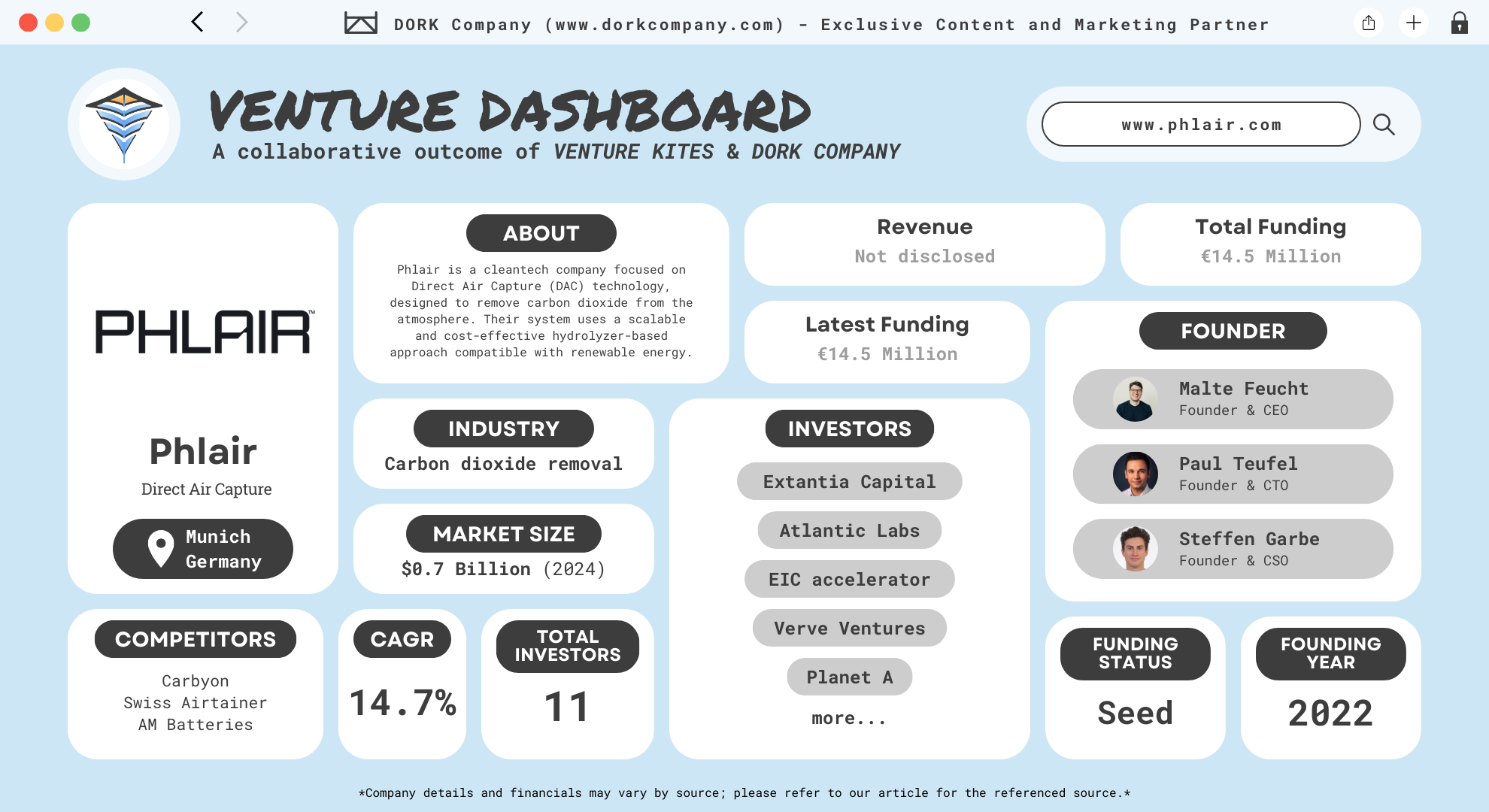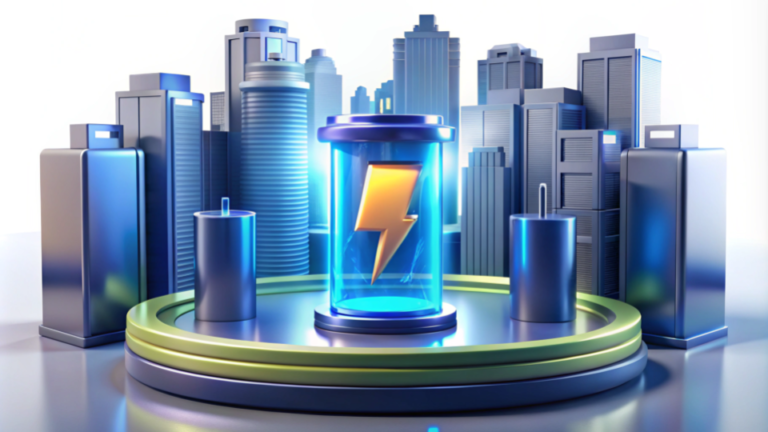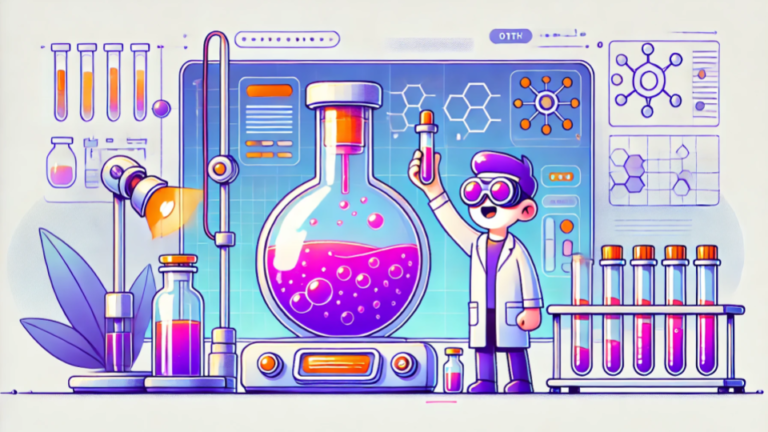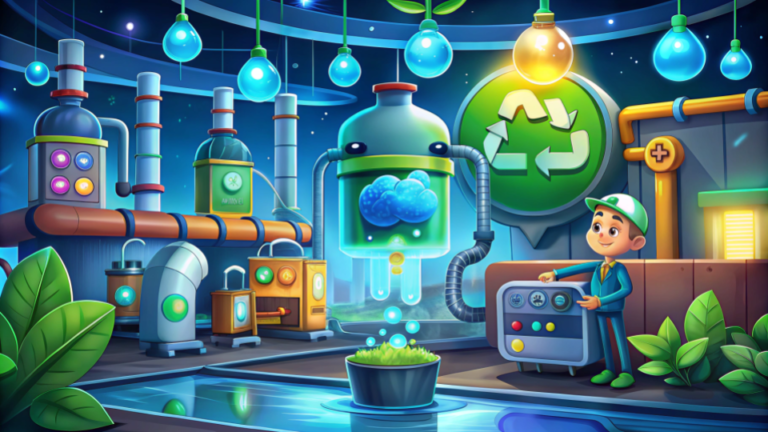Phlair-ing Up the Skies: A Startup Capturing Carbon and Attention

This startup is literally cleaning the air – Say hello to Phlair from Munich! Founded in 2022 in Munich, Germany, by Malte Feucht, Paul Teufel, and Steffen Garbe, Phlair is tackling one of the world’s biggest problems: carbon dioxide (CO2) emissions. Their goal is ambitious yet simple: remove CO2 from the atmosphere using their cutting-edge Direct Air Capture (DAC) technology. (Phlair)
They’ve developed a system that captures CO2 directly from the air and offers businesses and individuals the opportunity to buy carbon removal credits. These credits are backed by real, measurable results, giving clients a way to reduce their carbon footprint, whether they are a giant enterprise like Shopify or an individual wanting to make a difference.
What makes Phlair unique is their approach. They focus on making carbon removal affordable and scalable. By using a technology that leverages renewable energy, their solution is not only environmentally friendly but also cost-effective.
Carbon Crusaders: The Brains Behind Phlair’s Green Dream
Phlair’s founding story is one of science meeting purpose. Malte Feucht, Paul Teufel, and Steffen Garbe, three graduates from the Technical University of Munich (TUM), came together to create Phlair in 2022. Their goal from the start was to develop a scalable, affordable Direct Air Capture (DAC) technology to address climate change.
Malte Feucht
Malte Feucht is the CEO of Phlair, which was formerly known as Carbon Atlantis. Feucht has a strong technical background, having studied at the Technical University of Munich, where he earned both his Bachelor’s in Technology and Management and a Master’s in Robotics, Cognition, and Intelligence.
Feucht’s career has been rooted in machine learning and robotics, with significant experience at companies such as Doctos GmbH, where he worked as a Machine Learning Engineer and later as a Co-CTO. He also contributed as a Research Assistant at TU Munich, where he worked on the Hephaestus Project, developing a robotic platform for automating construction tasks like curtain wall installation. (Malte Feucht)
Paul Teufel
Paul Teufel is the CTO of Phlair. He has a strong academic background in engineering and artificial intelligence, having completed a Master of Science in Robotics, Cognition, and Intelligence from the Technical University of Munich.
Teufel has held several technical and leadership roles, including being a Co-CTO at Doctos GmbH, where he worked on machine learning and software solutions for automated medical coding. He also contributed to research at Harvard University, on functional connectomics, neuroscience, and machine learning as part of his thesis at the Lichtman and Engert Labs. (Paul Teufel)
Steffen Garbe
Steffen Garbe is the Chief Scientific Officer (CSO). Garbe has a strong background in electrochemistry and strategic consulting. He holds a PhD in Electrochemistry from ETH Zürich and an MBA from Collège des Ingénieurs. Prior to founding Phlair, Garbe worked as a consultant at Apricum – The Cleantech Advisory, focusing on market research and strategy in the energy storage sector. He also served as an Innovation Consultant at Merck KGaA, where he managed early-stage projects in renewable energy and biochemicals. (Steffen Garbe)
Market on the Rise: CO₂ Removal’s Time to Shine
Carbon dioxide removal (CDR) is booming, and it’s not just a trend—it’s essential for saving the planet. As the world pushes to meet net-zero emissions targets, the CDR market is expected to see a massive surge. In 2024 the global CDR market was valued at $0.7 billion and is projected to reach $1.5 billion in 2029 growing at an impressive 14.7% compound annual growth rate (CAGR). (Market Data Forecast)
The driving force behind this rapid growth? Urgent climate goals. The Paris Agreement and other international pacts make it clear: we can’t meet global warming limits without actively removing CO2 from the atmosphere. CDR technologies, like Direct Air Capture (DAC), biochar, and enhanced weathering, play a critical role in reversing historical emissions.
North America is currently dominating the space, thanks to heavy investments in carbon capture and robust government incentives. But Europe is catching up, largely due to strong legal frameworks encouraging climate action. Asia-Pacific is expected to be the fastest-growing region, fueled by rising awareness of climate change and investments in clean energy. (Research and Markets)
However, challenges remain. High energy costs and the need for advanced verification systems are holding back even faster adoption of CDR technologies. Additionally, debates around the role of CDR in the overall climate transition, especially concerns about environmental impact, need to be resolved.
About The Company: How Phlair is Capturing the Future
Phlair is transforming the carbon removal industry with one clear goal: to make carbon dioxide removal scalable and affordable for everyone. Their mission is simple yet powerful—to develop the most cost-effective Direct Air Capture (DAC) technology on the market. (About Phlair)
Phlair’s vision is to help individuals, businesses, and governments reach net-zero emissions faster by capturing CO₂ directly from the air. They focus on removing unavoidable emissions, which is key to closing the gap for companies and governments trying to meet climate goals. Phlair offers permanent carbon removal credits verified by Isometric, ensuring every ton of CO₂ captured is accounted for and stored safely.
Problems Phlair Solves
The problems Phlair addresses are: high carbon emissions and the lack of scalable, cost-effective carbon removal solutions. By using a hydrolyzer-based DAC technology, Phlair removes CO₂ from ambient air and either stores it permanently or uses it to produce carbon-negative chemicals. This unique approach is also compatible with intermittent renewable energy sources, making it ideal for large-scale deployment.
Business Model
Phlair’s business model revolves around selling carbon removal credits to enterprises and individuals. They target everyone, from large corporations like Shopify and Stripe to small businesses and even individuals looking to offset their carbon footprint. Their long-term goal is to reduce the cost of carbon removal to below $100 per ton, making it more accessible to businesses of all sizes.
CO₂ Solutions, Tailor-Made: Phlair’s Suite of Clean-Tech
Phlair is revolutionizing carbon removal with a diverse portfolio designed to tackle CO₂ emissions at every level. The company’s main product is its hydrolyzer-based Direct Air Capture (DAC) technology. This scalable solution captures CO₂ from the atmosphere and either stores it permanently or converts it into carbon-negative chemicals, like methanol or eSAF (sustainable aviation fuel). Phlair’s DAC systems are highly flexible, powered entirely by renewable energy without the need for battery storage, making them ideal for 24/7 carbon capture.
One of Phlair’s flagship offerings is its carbon removal credits. Businesses and individuals can purchase these credits to offset unavoidable emissions. These credits are independently verified by Isometric, ensuring transparency and accountability. Phlair also offers modular DAC systems for project developers. These “futureware” systems allow companies to purchase the hardware and software necessary to run their own carbon capture operations.
Electra 00
Electra 00 is Phlair’s pilot DAC plant based in Ismaning, Germany, was launched in 2024. This facility will capture and mineralize 10 tons of CO₂ annually, pioneering Phlair’s modular approach to carbon removal. The captured CO₂ will be converted into carbon credits, which are sold to various industries as a verified way to offset their emissions. This small-scale project demonstrates Phlair’s ability to capture and store CO₂ effectively and lays the groundwork for larger-scale plants. (Electra 00)
Electra 01
The Electra 01 project is the next big step in Phlair’s journey, scheduled for completion by late 2025. Located in Rotterdam, Netherlands, this plant will have the capacity to remove 260 tons of CO₂ per year. This is Phlair’s first fully commercial DAC project, built in collaboration with Paebbl, specializing in CO₂ storage. This is the first EU DAC & mineralization plant, storing captured CO2 into construction materials. The carbon captured here will be sold to companies like Shopify and Stripe as part of their sustainability initiatives. (Electra 01)
Electra 02
Electra 02 marks Phlair’s expansion into North America. This project, in collaboration with Canadian project developer Deep Sky, will also go live by late 2025. Similar to Electra 01, Electra 02 will capture over 260 tons of CO₂ annually. This facility represents Phlair’s entry into the North American market, utilizing its modular DAC technology to cater to industries focused on large-scale carbon offsets. (Electra 02)
Dawn
The Dawn project, slated for mid-2026, is Phlair’s most ambitious initiative yet. This large-scale facility will capture more than 20,000 tons of CO₂ per year, making it one of the biggest DAC operations in the world. The Dawn project is designed to provide durable carbon removal credits to industries seeking long-term, verifiable emissions reductions. This is a major milestone towards our long-term cost target of less than $100 per ton of CO2. (Dawn)
The Science of Cleaning: Phlair’s Game-Changing Hydrolyzer Tech
Phlair’s Direct Air Capture (DAC) technology isn’t just cutting-edge—it’s cost-cutting too. Their system uses a pH-swing method to capture CO₂. Direct Air Capture (DAC) is a carbon removal technology designed to extract CO₂ directly from the air. DAC functions like a high-tech air purifier for the planet, pulling in ambient air, extracting CO₂, and then either storing it permanently underground or repurposing it for industrial use, such as creating synthetic fuels. (Phalir’s Technology)
One of the primary benefits of DAC is that it can operate independently of where emissions are produced. This means DAC systems can be deployed globally and can capture CO₂ directly from the atmosphere, even in remote areas. However, one major challenge in DAC systems is their energy intensity and cost.
Hydrolyzer
Phlair’s core innovation lies in its cutting-edge Hydrolyzer, which produces acids and bases at significantly lower costs than traditional methods. This breakthrough is inspired by advancements in Proton Exchange Membrane (PEM) fuel cells and electrolyzers, allowing Phlair’s unique cell architecture to support industrial-sized stacks for large-scale operations.
Although Phlair currently applies its technology to Direct Air Capture (DAC), its Hydrolyzer’s potential spans a wide array of carbon removal and abatement applications. These include critical mineral mining, ocean alkalinity enhancement, and point source carbon capture in industries like aluminum production, showcasing the versatility of their solution in driving carbon reduction efforts.
What is the pH-Swing Method?
The pH-swing method is a novel approach to DAC that Phlair uses to reduce the energy requirements and costs associated with traditional DAC technologies. Here’s how it works:
- Absorption Stage: Air is blown over a solvent with a high pH (basic), which reacts with and absorbs CO₂ from the air.
- CO₂ Release Stage: The CO₂-saturated solvent is then exposed to an acid (low pH). This causes a chemical reaction that “swings” the pH balance, releasing the CO₂ from the solvent.
- Regeneration Stage: The solvent is regenerated by reversing the chemical reaction, allowing it to be reused in the process, while the captured CO₂ is collected for storage or utilization.
This method is part of what makes Phlair’s DAC technology cost-efficient and scalable, with the long-term goal of capturing CO₂ for under $100 per ton—a major leap forward from traditional systems that can cost upwards of $600-$1,000 per ton.
Powerful Impact : Phlair’s bold vision for the future
Phlair’s hydrolyzer-based DAC system has been recognized for its scalability, affordability, and compatibility with renewable energy, positioning Phlair as a leader in the fight against climate change. Phlair has already secured several high-profile clients, including Shopify, Stripe, Klarna, and Deep Sky, who are eager to support carbon removal initiatives through Phlair’s verified carbon removal credits.
Phlair is also participating in Frontier, a billion-dollar initiative formed by major companies like Alphabet, Meta, and Stripe to advance carbon removal solutions. With costs projected to drop below $100 per ton of CO₂—compared to the current industry average of $341 per ton—Phlair makes carbon capture more accessible for a wider range of industries and governments.
Stripe, in particular, has been a key partner in supporting Phlair’s mission. Through Stripe’s Climate Program, Phlair is one of the select startups chosen to receive investments for scaling their technology. Another notable partner is Deep Sky, which has collaborated with Phlair on large-scale projects in North America. Deep Sky focuses on building carbon removal infrastructure, and together with Phlair, they are developing plants capable of capturing tens of thousands of tons of CO₂ per year.
Phlair’s first major funding round took place in September 2024, where the startup raised €14.5 million in seed funding. This round was led by Extantia Capital with participation from notable investors such as Planet A, Verve Ventures, and a €2.5 million grant from the EIC accelerator. Existing investors like Atlantic Labs, Counteract, and UnternehmerTUM Funding for Innovators also contributed. (Techcrunch) (EU-Startups)
Breathing Easy: Phlair’s Big Ideas for a Cleaner Tomorrow
Phlair is a cutting-edge cleantech company focused on Direct Air Capture (DAC) technology to remove carbon dioxide (CO₂) from the atmosphere. Their innovative system uses a hydrolyzer-based approach, designed to be both scalable and affordable. By employing off-the-shelf components, Phlair’s DAC units can be mass-manufactured, which allows them to scale their operations more quickly and cost-effectively than traditional carbon capture technologies.
Phlair’s technology captures CO₂ by using a pH-swing mechanism, where basic solvents absorb CO₂ from the air, and acids release the CO₂ for capture and storage. This process is fully powered by electricity, which makes it compatible with intermittent renewable energy sources like solar and wind. Unlike some traditional DAC systems that require high heat, Phlair’s method is energy-efficient and doesn’t rely on costly thermal regeneration.
If you have a bold idea, now is the time to take action. Whether you’re working in tech, sustainability, or beyond, the world needs innovative minds to drive change. So, what’s your next big idea? For more inspiring stories about startups leading the way, make sure to check out other articles on Venture Kites.
At a Glance with DORK Company

Dive In with Venture Kites
Lessons From Phlair
Experiment and Iterate
The Lesson & Why it matters: The first version of your product might not be perfect. Experiment, learn from mistakes, and iterate quickly to improve.
Implementation: Create a culture of continuous improvement by testing ideas, gathering feedback, and iterating.
How Phlair implements it: Phlair developed and improved their DAC technology by iterating on early prototypes, refining their system to reduce costs and increase efficiency.
Innovate to Reduce Costs
The Lesson & Why it matters: Innovation isn’t just about creating new products—it’s also about reducing costs. Lower costs make your solution more competitive and accessible.
Implementation: Constantly seek ways to refine your processes or products to reduce costs without sacrificing quality.
How Phlair implements it: Phlair is pioneering a hydrolyzer-based Direct Air Capture (DAC) technology, reducing the cost of carbon removal to below $100 per ton, compared to the typical $341. This makes it a more affordable and scalable solution.
Design for Compatibility with Renewable Energy
The Lesson & Why it matters: Solutions that work seamlessly with renewable energy sources are future-proof and more sustainable.
Implementation: Ensure your technology or product can be integrated with renewable energy sources to stay relevant as the world shifts towards greener options.
How Phlair implements it: Phlair’s DAC system is designed to operate with intermittent renewable energy, eliminating the need for additional battery storage and making it more cost-effective.
Leverage Existing Technologies
The Lesson & Why it matters: You don’t need to reinvent the wheel. Use existing technologies where possible to cut down on R&D costs and time to market.
Implementation: Identify proven, scalable technologies that can be adapted to your specific needs.
How Phlair implements it: Phlair utilizes off-the-shelf components, which accelerates production and lowers costs. This also allows for rapid scalability.
Collaborate with Big Players
The Lesson & Why it matters: Strategic partnerships with larger, well-established companies can accelerate your growth and open new markets.
Implementation: Identify and partner with industry leaders who align with your goals and can provide more than just financial backing.
How Phlair implements it: Phlair has partnered with major companies like Shopify, Stripe, and Klarna, which are early adopters of their technology, helping them to scale faster.
Youtube Shorts
Author Details
Creative Head – Mrs. Shemi K Kandoth
Content By Dork Company
Art By Dork Company
Instagram Feed
X (Twitter) Feed
🌍 Introducing Phlair: The Startup Capturing Carbon and Cleaning the Air! 🌱💨
— Venture Kites (@VentureKites) November 3, 2024
Let’s explore how this Munich-based startup is tackling climate change with innovative Direct Air Capture (DAC) tech. 👇👇#Cleantech #ClimateAction #Phlair












